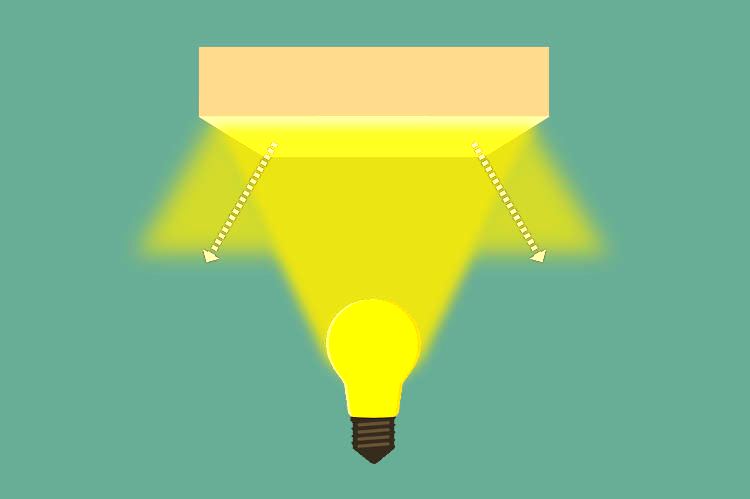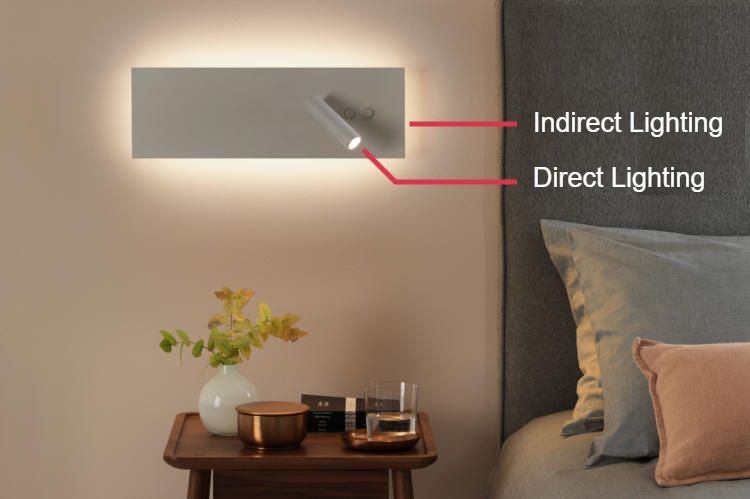Indirect lighting, which is perceived as “soft”, is extremely popular in the interior. However, it is not sufficient for various visual tasks, which is why you can find a combination of indirect lighting and direct lighting in living rooms.
Together, they create a harmonious lighting ambiance in the living room and individually balanced lighting for every activity. Indirect light is hardly used at all in the outdoor area since the functional principle is based on reflections and there are hardly any reflective walls and ceilings in the outdoor area.
What is indirect lighting?
Indirect lighting is any light that is first reflected from the ceiling or wall before it shines into the room.
Thus, the term indirect light summarizes all light sources that are aligned with the wall or the ceiling.
The light first reflects from these surfaces and emit into the room.
It is true that indirect light can also include atmospheric decorative lighting.
For example, if LED strips are attached under the sofa and the LED light gives the piece of furniture a colored contour.
However, indirect light is much more than ambient lighting.

Indirect light of the room through reflection on the ceiling or wall.
Where can you use indirect light?
Indirect lighting is designed to provide lighting by reflecting light directed towards the wall or ceiling.
Indirect lighting is extremely relevant for a lighting technology feel-good atmosphere. This has to do with the fact that the indirect light reflected from the ceiling or wall is evenly distributed, does not dazzle and is therefore generally pleasantly “soft”.
Indirect lighting is therefore used to create a basic lighting level for various living rooms. These include the living room, bedroom or even the dining room. Indirect light, therefore, takes on the task of general lighting or basic lighting.
Features of indirect lighting
Indirect lighting is perceived as “soft” in the living room.
The reflection on the ceiling or wall creates a glare-free, by no means disturbing light, since the light source cannot be seen.
In addition, so-called reflex glare does not occur with indirect light that falls on a reflective surface such as screens or high-gloss paper.

This wall lamp combines indirect light with the direct light of a reading lamp.
Because there are no dazzling or annoying reflections and the light is almost completely free from drop shadows, it ensures uniform illumination of the room. This gives a very pleasant feeling.
However, indirect light is also diffuse and therefore rather unsuitable for various visual tasks, such as reading or working with documents.
In addition, the this light creates only very soft shadows. Modeling with light, i.e. underlying structure and depth, cannot be achieved with indirect light.
How to create indirect light?
To create indirect light, you can use a wide variety of lamps.
This is because indirect light is always generated when a light source is aligned with the wall or ceiling. And, as can be seen above, this can be the case with very different lamps and bulbs (for example head mirror lamps).
A prime example of a lamp that emits indirect light is the uplighter.
A ceiling washer has a lampshade similar to a bowl at the top, which only shines the light upwards towards the ceiling. The upward light of the ceiling washer is reflected by the ceiling and ensures a soft, even illumination of the room.
Some ceiling wash lights have an additional reading arm with reading lighting. A single lamp shows the combination of indirect (up lighter) and direct (reading lighting) light. The light from the reading arm is used as a directed, direct light to accomplish the visual task of reading.
If the light should not be directed towards the ceiling but towards the wall (perhaps also due to a better reflection effect due to a lighter wall surface than the ceiling surface), appropriately designed wall lights can be used.
Wall lights for this purpose usually have one-sided or two-sided light emission upwards, downwards or to the sides. This ensures glare-free room lighting, which in many cases is supported by other lights.



